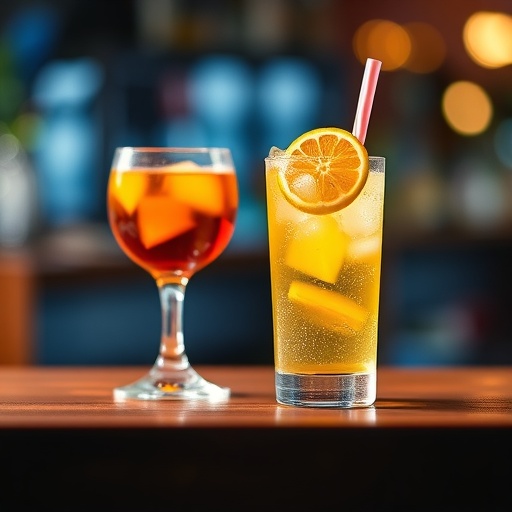
In recent years, the beverage industry has witnessed a significant surge in the availability and popularity of alcohol-free and low-alcohol drinks. This trend is not merely a reflection of shifting consumer preferences among adults but has shown intriguing patterns specifically among adolescents. New comprehensive research sheds light on this phenomenon, exploring the factors that drive young people towards choosing these alternatives, and critically assessing the implications for their mental health and behavioral profiles. The study delves into existing literature and supplements it with an in-depth drinking profile analysis, providing a scientific understanding that challenges traditional narratives around adolescent alcohol consumption.
Understanding adolescent behavior regarding alcohol consumption has always been a complex interdisciplinary challenge, ranging from social psychology to neuroscience. Historically, the focus has been on reducing underage drinking and preventing the associated long-term risks of alcohol abuse. However, the landscape is evolving as alcohol-free and low-alcohol beverages become more mainstream. These products, which typically contain less than 0.5% alcohol by volume (ABV) for alcohol-free or up to approximately 1.2-2.5% ABV for low-alcohol drinks, offer a seemingly safer alternative. Their rising consumption among adolescents necessitates a nuanced exploration of whether these beverages act as harm-reduction tools or gateways to risky drinking behaviors.
The reviewed literature underscores that the increasing availability of non-alcoholic options is partly a response to broader alcohol harm reduction policies and changing societal attitudes towards health and well-being. Adolescents today are more health-conscious and socially aware than previous generations, which influences their consumption habits. The normalized presence of alcohol-free and low-alcohol drinks in social settings aligns well with this mindset, potentially facilitating social inclusion without the risks traditionally associated with alcohol consumption. However, questions arise about whether this normalization might inadvertently reinforce drinking cultures under a different guise.
.adsslot_6GZSMhlpDq{width:728px !important;height:90px !important;}
@media(max-width:1199px){ .adsslot_6GZSMhlpDq{width:468px !important;height:60px !important;}
}
@media(max-width:767px){ .adsslot_6GZSMhlpDq{width:320px !important;height:50px !important;}
}
ADVERTISEMENT
From a neurodevelopmental perspective, adolescence is a critical period marked by ongoing brain maturation, especially in areas related to impulse control, decision-making, and risk assessment. Introducing any alcohol, even in minimal quantities, could have subtle yet significant effects on these processes. The reviewed research highlights experimental evidence suggesting that low levels of alcohol exposure during adolescence may alter neural pathways and neurotransmitter systems, potentially influencing future susceptibility to addiction or other mental health disorders. Consequently, even alcohol-free drinks that might contain trace amounts of ethanol warrant scientific scrutiny.
Cultural and environmental factors also play a decisive role in shaping adolescent drinking patterns. Socioeconomic status, peer influence, parental attitudes, and media representations converge to create complex behavioral ecosystems. The study’s comprehensive drinking profile analysis reveals that adolescents consuming alcohol-free or low-alcohol beverages often display distinct social motives compared to their peers who consume traditional alcoholic drinks. For example, these adolescents are more inclined to prioritize social bonding and peer acceptance over intoxication or rebellion, which could reflect broader shifts in youth culture.
While the consumption of alcohol-free and low-alcohol beverages may circumvent some immediate physical harms—such as acute intoxication or alcohol poisoning—long-term psychological implications remain less understood. The reviewed evidence points to a potential risk that reliance on these substitutes might sustain or even normalize the association between alcohol and socialization. This dynamic could impede efforts to establish entirely alcohol-free norms among young populations and complicate messaging around responsible drinking.
Technological advances in beverage formulation have significantly expanded the quality and variety of alcohol-free and low-alcohol options available. Previous iterations often suffered from inferior taste profiles, which limited their appeal among any demographic. The new generation of products, engineered through sophisticated fermentation control and flavor enhancement methods, mimics traditional alcoholic drinks with remarkable fidelity. This technological progress, while commercially advantageous, introduces questions about how sensory experiences interact with adolescent expectations and drinking rituals.
Furthermore, marketing strategies exert profound influence over adolescents’ beverage choices. Brands attempting to capture younger markets employ targeted campaigns emphasizing lifestyle, identity, and wellness rather than intoxication. Labeling and packaging aesthetics are meticulously designed to appeal to youth sensibilities, blurring lines between alcohol and non-alcoholic segments. The regulatory environment around advertising alcohol-free products to minors varies widely across jurisdictions, creating challenges for policymakers seeking to balance commercial freedom with public health priorities.
The article also explores epidemiological data capturing trends across multiple countries and demographic groups. It reveals that consumption rates for these alternative drinks tend to cluster in urban, higher-income adolescent populations, often correlated with elevated educational attainment and parental supervision levels. Such data suggest that subsets of youth utilize alcohol-free or low-alcohol drinks as part of deliberate risk-avoidance strategies, further complicating the simplistic dichotomy of “drinkers” versus “non-drinkers.”
Psychometrically, the study’s drinking profile analysis integrates variables such as frequency, context, peer group characteristics, and motivational factors. It employs advanced statistical models to disentangle overlapping behavioral phenotypes and assess whether alcohol-free and low-alcohol drink consumption aligns more with experimental, social, or dependent drinking profiles. These insights are crucial for developing tailored interventions and educational programs that reflect the diversity of adolescent experiences.
Importantly, mental health dimensions are interwoven throughout the analysis. Alcohol use during adolescence has long been linked to increased incidences of depression, anxiety, and cognitive impairments. Understanding how substitutive consumption of low or zero-alcohol products modifies these risks is critical. Preliminary findings reviewed suggest mixed outcomes, with some adolescents benefiting from reduced exposure to high alcohol content and others potentially maintaining maladaptive drinking patterns under the guise of “safe” products.
The research also scrutinizes parental and school influences on adolescent drinking choices. Data indicate that open communication about alcohol risks, coupled with availability of appealing alcohol-free alternatives, can reduce harmful consumption patterns. Conversely, environments lacking such dialogue or resources may see adolescents gravitating towards clandestine or higher-risk drinking behaviors, regardless of product type.
From a policy standpoint, this body of work advocates for nuanced approaches that recognize the dual-edged nature of alcohol-free and low-alcohol drinks. Blanket prohibitionist attitudes may inadvertently diminish opportunities for harm reduction, whereas unregulated promotion risks normalizing alcohol consumption among vulnerable youth. Policies integrating education, accessibility controls, and empirical monitoring can create safer frameworks for adolescent beverage consumption.
The research concludes by calling for longitudinal studies that track neurocognitive outcomes, social trajectories, and psychological health of adolescents consuming alcohol-free and low-alcohol drinks over extended periods. Such investigations would clarify causality and inform evidence-based recommendations. The intersection between emerging consumer trends, technological innovation, and adolescent development stands as a critical frontier for addiction science and public health.
In sum, this exploration of adolescents’ consumption of alcohol-free and low-alcohol drinks represents a pivotal contribution to
Tags: adolescents and alcohol consumption trendsalcohol alternatives and youth culturealcohol-free beverage popularity among youthchanging attitudes towards underage drinkingdrinking profiles of adolescentsfactors influencing adolescent drink choicesharm reduction strategies for underage drinkingimplications of alcohol-free drinks on behaviorlow-alcohol drinks and mental healthneuroscience of alcohol-free alternativessocial psychology of adolescent alcohol useunderstanding adolescent beverage preferences





